stop start AUDI A3 CABRIOLET 2016 User Guide
[x] Cancel search | Manufacturer: AUDI, Model Year: 2016, Model line: A3 CABRIOLET, Model: AUDI A3 CABRIOLET 2016Pages: 272, PDF Size: 67.88 MB
Page 67 of 272
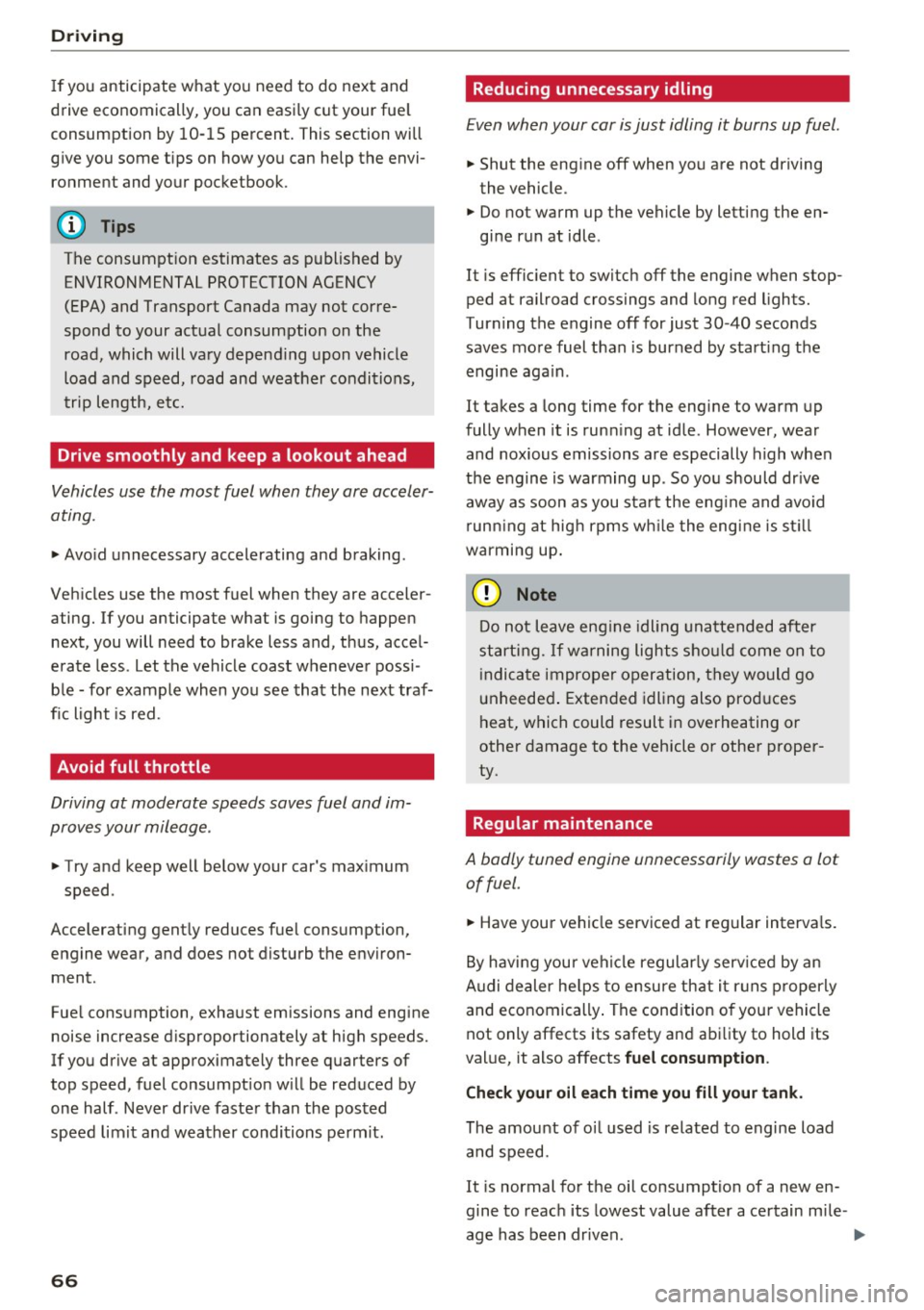
Driving
If you anticipate what you need to do next and
drive economically, you can easily cut your fuel
consumption by 10-15 percent. This section will
give you some tips on how you can help the envi ronment and your pocketbook.
(D Tips
The consumption estimates as published by ENVIRONMENTAL PROTECTION AGENCY
(EPA) and Transport Canada may not corre
spond to your actual consumption on the
road, which will vary depending upon vehicle
load and speed, road and weather conditions,
trip length, etc.
Drive smoothly and keep a lookout ahead
Vehicles use the most fuel when they are acceler
ating.
.. Avoid unnecessary accelerating and braking .
Vehicles use the most fuel when they are acceler
ating. If you anticipate what is going to happen next, you will need to brake less and, thus, accel
erate less. Let the vehicle coast whenever possi
ble -for example when you see that the next traf
fic light is red.
Avoid full throttle
Driving at moderate speeds saves fuel and im
proves your mileage.
.. Try and keep well below your car's maximum
speed .
Accelerating gently reduces fuel consumption,
engine wear, and does not disturb the environ ment.
Fuel consumption, exhaust emissions and engine
noise increase disproportionately at high speeds.
If you drive at approximately three quarters of
top speed, fuel consumption will be reduced by
one half . Never drive faster than the posted
speed limit and weather conditions permit.
66
· Reducing unnecessary idling
Even when your car is just idling it burns up fuel .
.. Shut the engine off when you are not driving
the vehicle .
.,. Do not warm up the vehicle by letting the en-
gine run at idle .
It is efficient to switch off the engine when stop
ped at railroad crossings and long red lights.
Turning the engine off for just 30 -40 seconds
saves more fuel than is burned by starting the
engine again .
It takes a long time for the engine to warm up
fully when it is running at idle . However, wear
and noxious emissions are especially high when
the engine is warming up . So you should drive
away as soon as you start the engine and avoid running at high rpms while the engine is still
warming up .
@ Note
Do not leave engine idling unattended after
starting. If warning lights should come on to
indicate improper operation, they would go
unheeded. Extended idling also produces
heat, which could result in overheating or
other damage to the vehicle or other proper
ty.
Regular maintenance
A badly tuned engine unnecessarily wastes a lot
of fuel.
.. Have your vehicle serviced at regular intervals.
By having your vehicle regularly serviced by an
Audi dealer helps to ensure that it runs properly
and economically. The condition of your vehicle
not only affects its safety and ability to hold its
value, it also affects
fuel consumption.
Check your oil each time you fill your tank.
The amount of oil used is related to engine load
and speed.
It is normal for the oil consumption of a new en
gine to reach its lowest value after a certain mile -
age has been driven . ..,.
Page 69 of 272
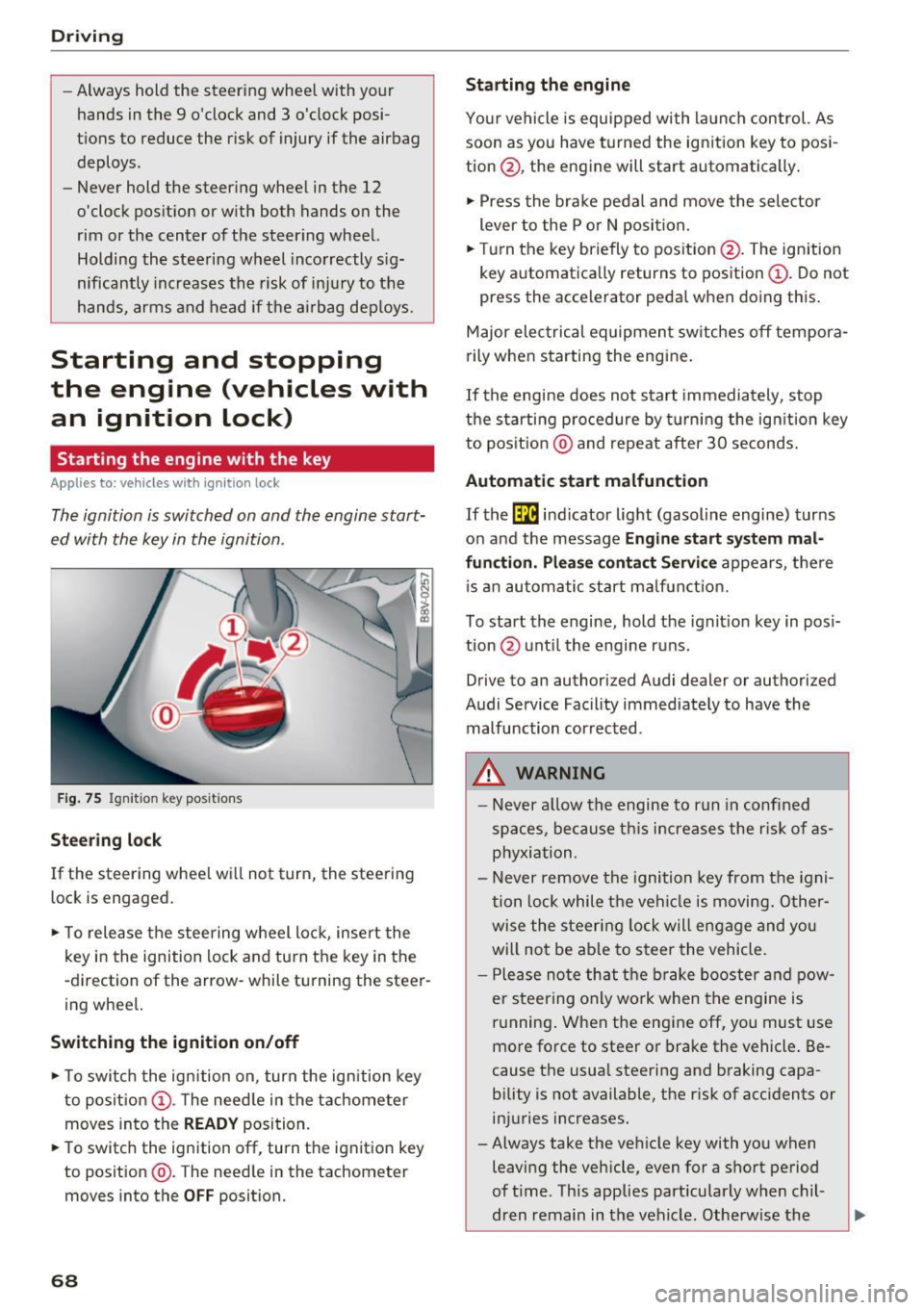
Driving
-Always hold the steering wheel with your
hands in the 9 o'clock and 3 o'clock posi
t ions to reduce the risk of injury if the airbag
deploys.
- Never hold the steer ing whee l in the 12
o'clock posit ion or w ith both hands on the
rim or the center of the steer ing whee l.
Holding the steering wheel inco rrectly s ig
nificantly incr eas es the risk of inju ry to the
hands, arms and head if t he ai rbag dep loys .
Starting and stopping
the engine (vehicles with
an ignition Lock)
Starting the engine with the key
A pp lies to: ve hicles w ith ig ni tio n lock
The ignition is switched on and the engine start
ed with the key in the ignition .
Fig . 75 Ig nit io n key pos it ions
Stee ring lock
If the steering whee l w ill not turn, the steering
lock is engaged .
• To release the steering wheel lo ck, inse rt the
k ey in the ignition lock and tu rn t he key in the
-d irection of the arrow- while tu rning the steer
ing wheel.
Sw itching the ignition on/off
• To switc h the ignition on, turn the ign ition key
to posit io n @ . The need le in the tachometer
moves into the
READY position.
• To switc h the ign ition off , turn the ignit ion key
to position @. T he need le in the tachometer
moves into the
OFF position.
68
Starting the engine
Yo ur vehicle is equipped wi th la unch control. As
soon a s you have turned the ign ition key to pos i
tion @, the engine will start automatically .
• Press the bra ke pedal and move the sele ctor
lever to the P o r N posi tion.
• Turn the key br iefly to posit ion @. The ignition
key a utomat ica lly returns to position @. Do not
press the accelerator peda l when do ing this .
Major elec trical equipmen t sw itches off tempora
rily when s tarting the engine .
If the engine does not start immediately, stop
t h e starti ng p ro cedure by t urnin g the ig nition key
to pos it ion @ and repeat after 30 seconds.
Automatic start malfunction
If the ~ in dicator light (gasoline engine) tur ns
on and the message
Engine start sy stem mal
fun ction . Please contact Servic e
appears, t he re
i s an a utom atic start ma lf u n ct io n.
To start the engine, hold t he ignit io n key in pos i
t ion @ unt il the engine r uns.
Drive to an authorized Audi dealer or authorized
Audi Service Facility immediate ly to have the
malfunction correc ted.
A WARNING
- Never a llow th e engine to run in confined
sp aces, because this increases the r is k of as
phyxia tion.
- Never remove the ignition key from the igni
tion lock while t he ve hicl e is moving . Other
w ise the s teering lo ck will engage and yo u
will no t be ab le to s teer the vehicle.
- P lease no te th at the b rake booster and p ow
e r steering only wo rk when the engine is
r u nning . When the engine off, you must use
more force to steer or bra ke the vehicle . Be
cause the usua l steering and braking capa
bility is not available, the risk of acc idents or
in juries increases.
- Always take the veh icle key with yo u when
leaving the vehicle, even for a sho rt pe riod
of t ime. This applies part icularly when chil
dren remain in the vehicle. Otherwise the
Page 70 of 272
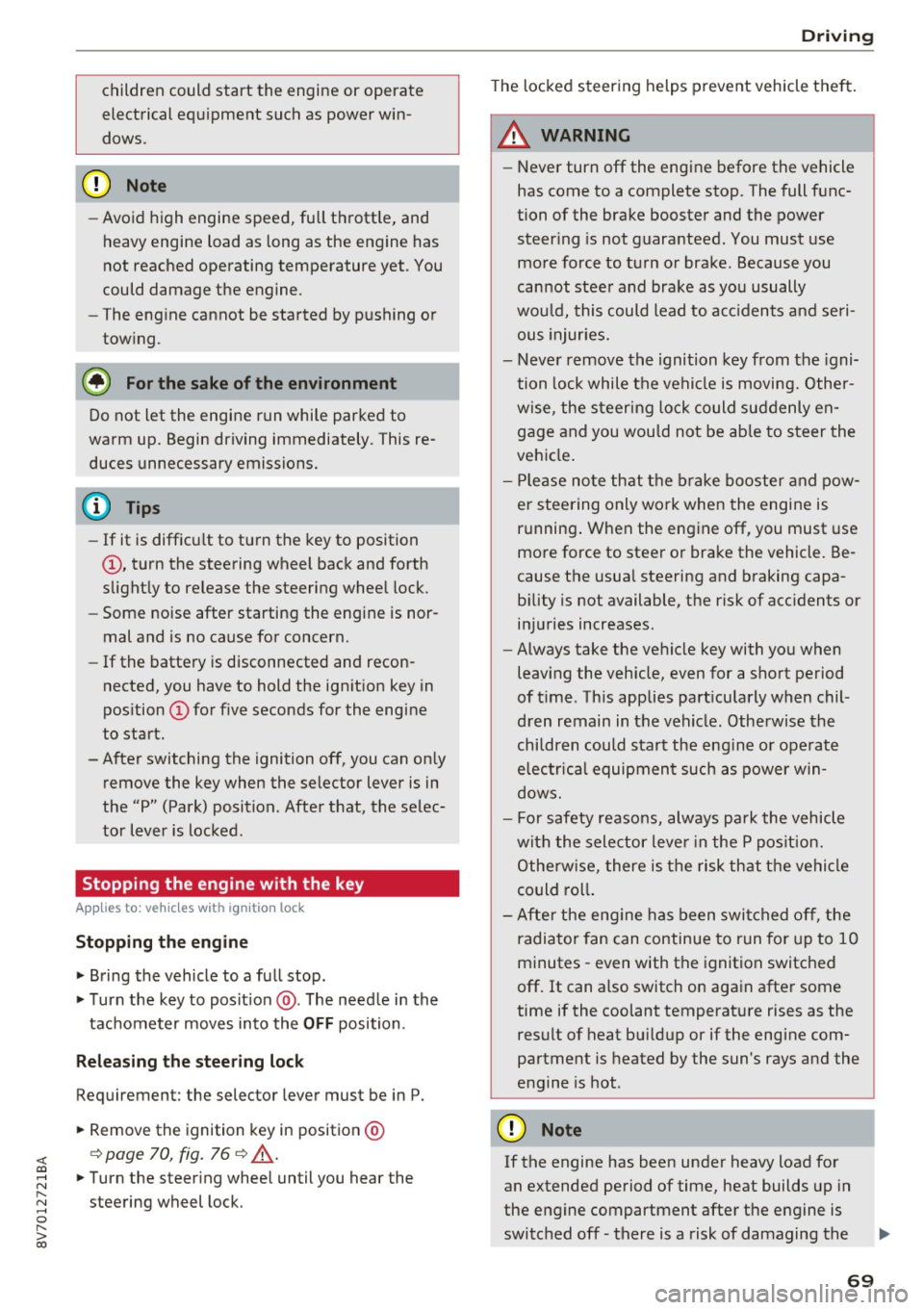
<( co .... N r--N .... 0 ,.__
> co
children could start the engine or operate
electrical equipment such as power win
dows.
0 Note
-Avoid high engine speed, fu ll throttle, and
heavy engine load as long as the engine has
not reached operating temperature yet . You
could damage the engine.
- The engine cannot be started by pushing or
towing .
@ For the sake of the environment
Do not let the engine run while parked to
warm up. Begin driving immediately. This re
duces unnecessary emissions.
- If it is difficu lt to turn the key to position
(D, turn the steering wheel back and forth
slightly to release the steering wheel lock .
- Some noise after starting the engine is nor
mal and is no cause for concern.
- If the battery is disconnected and recon
nected, you have to hold the ign ition key in
position
(D for five seconds for the engine
to start.
-After switching the ignition off, you can on ly
remove the key when the selector lever is in
the "P" (Park) position. After that, the selec
tor lever is locked .
Stopping the engine with the key
Appl ies to: ve hicles w ith igni tion loc k
Stopping the engine
~ Bring the vehicle to a full stop.
~ Turn the key to posit ion @. The need le in the
tachometer moves into the
OFF position .
Releasing the steering lock
Requirement: the selector lever must be in P.
~ Remove the ignition key in position@
¢page 70, fig. 76 ¢ _A.
~ Turn the steering wheel until you hear the
steering wheel lock.
Driving
T he locked steering helps prevent vehicle theft .
A WARNING
-
-Never turn off the engine before the vehicle
has come to a complete stop . The full func
tion of the brake booster and the power
steer ing is not guaranteed. You must use
more force to turn or brake. Because you
cannot stee r and brake as you usually
wou ld, this could lead to acc idents and seri
ous injuries.
- Never remove the ignition key from the igni
tion lock while the vehicle is moving. Other
wise, the steering lock could suddenly en
gage and you wou ld not be able to steer the
vehicle.
- Please note that the brake booster and pow
er steering only work when the engine is
running . When the engine off, you must use
more force to steer or brake the vehicle. Be
cause the usua l steering and braking capa
b ili ty is not available, the risk of acc idents or
injuries increases.
- Always take the vehicle key with you when
leaving the vehicle, even for a short period
of t ime . This applies part icularly when chil
dren remain in the vehicle . Otherwise the
children could start the engine or operate
electrical equipment such as power win
dows.
- For safety reasons, always park the vehicle
w ith the selector lever in the P position.
Othe rw ise, there is the risk that the vehicle
could rol l.
- After the engine has been switched off, the
radiator fan can continue to run for up to 10
minutes -even with the ignition switched
off . It can also switch on again after some
time if the coolant temperature rises as the
result of heat bu ildup or if the engine com
partment is heated by the sun's rays and the
engine is hot.
(D Note
If the engine has been under heavy load for
an extended period of time, heat builds up in
the engine compartment after the engine is
switched off -there is a risk of damaging the
69
Page 71 of 272
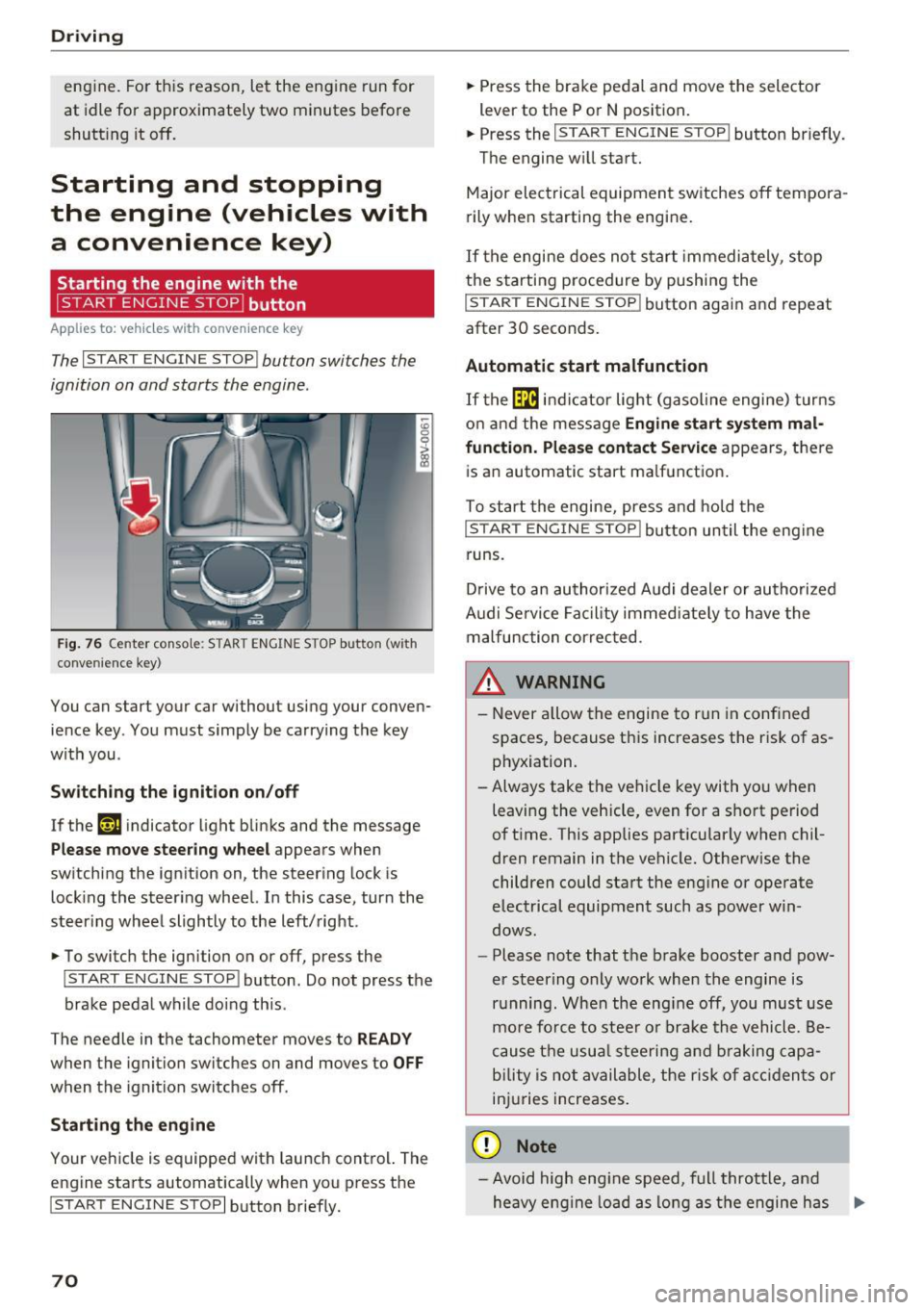
Driving
engine. For this reason, let the engine run for
at idle for approximately two minutes before
shutt ing it off.
Starting and stopping
the engine (vehicles with
a convenience key)
St rt · th . ith the
button
App lies to: ve hicles w ith conve nien ce key
The I ST ART E NGIN E STOP I button switches the
ignition on and starts the engine .
Fig . 76 Ce nter conso le: STAR T ENG IN E ST O P butto n (wit h
conve nie n ce key)
You can start your car without using your conven
ience key . You must simply be carrying the key
with you .
Switch ing the ignit ion on /off
If thP ,7-u indicator light blinks and the message
Ple ase mo ve steer ing whee l appears when
sw itching the ignition on, the steer ing lock is
lock ing the steer ing wheel. In this case, turn the
steering whee l slightly to the left/right.
• To switch the ignition on or off, press the
I START ENGIN E STOP ! button. Do not press the
brake pedal while doing this .
T he needle in the tachometer moves to
R EAD Y
when the ignition swi tches on and moves to OFF
when the ignition switches off .
Starting the engine
Your vehicle is equipped with launch control. The
engine starts automatically when you press the
I S T AR T ENG INE S T OPI button briefly.
70
• Press the brake pedal and move the selector
lever to the P o r N position.
• Press the
I ST AR T ENGINE ST OP I button briefly.
The engine w ill start.
Major electrical equipment switches off tempora
rily when starting the engine.
If the engine does not s tart immediately , stop
the starting procedure by pushing the
I S T AR T ENGINE ST OP I button again and repeat
after 30 seconds.
Automatic start malfunction
If the ~ indicator light (gasoline engine) turns
o n and the message
Engine sta rt sy ste m mal
fun ction. Plea se contact Se rvice
appears, there
is an automatic start ma lfunction.
To start the engine, press and hold the
I S T AR T ENGINE STOP I button until the eng ine
runs.
D rive to an authori zed A udi dealer or authorized
A udi Se rvice Fac ility immediate ly to have the
malfunction correc ted .
& WARNING
- Never a llow the engine to run in confined
spaces, because this increases the risk of as
phyxiation.
- Always take the ve hicle key with you when
leavi ng the vehicle, even for a sho rt period
of t ime. This applies particularly when chil
dren remain in the vehicle. Otherwise the
children could start the eng ine or operate
electrical equipment such as power win
dows.
- Please note that the brake booster and pow
er steering only work when the engine is
running . When the eng ine off, you must use
more force to stee r o r brake the vehicle. Be
cause the usu al stee ring and b raking capa
bility is no t available, the risk of acc iden ts or
in juries increases .
(D Note
-
-Avoid high eng ine speed, full throttle, and
heavy eng ine load as long as the engine has
IJI>
Page 72 of 272
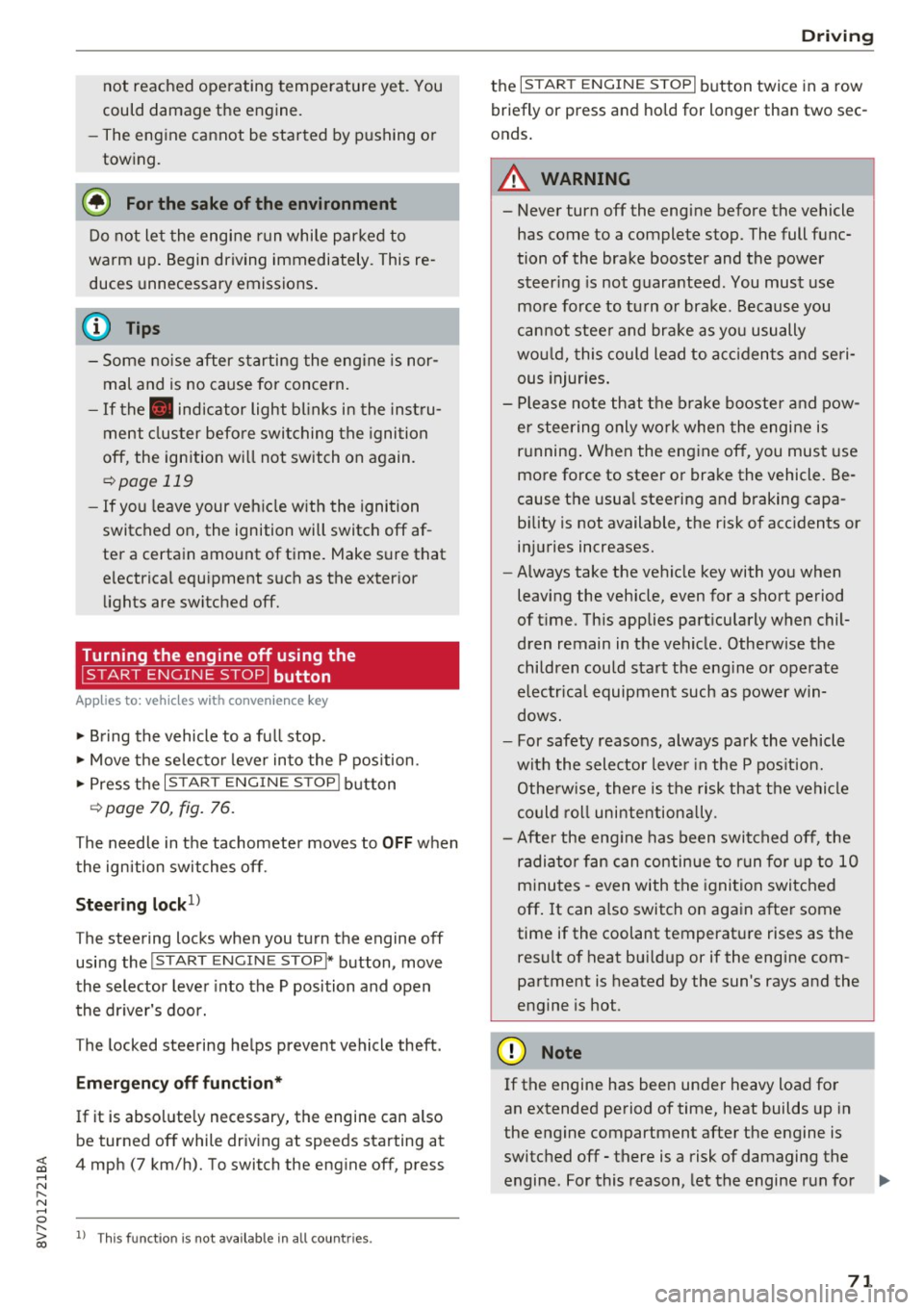
<( co .... N ,.__
N .... 0 ,.__
> co
not reached operating temperature yet. You
could damage the engine.
- The engine cannot be started by pushing or
towing.
@) For the sake of the environment
Do not let the engine run while parked to
warm up. Begin driving immediately . This re
duces unnecessary emissions.
(D Tips
- Some noise after starting the engine is nor
mal and is no cause for concern.
- If the . indicator light blinks in the instru
ment cluster before switching the ignition
off, the ignition will not switch on again.
¢ page 119
-If you leave your vehicle with the ignition
switched on, the ignition will switch off af
ter a certain amount of time. Make sure that
electrical equipment such as the exterior lights are switched off.
T · th · ff using the
button
App lies to: vehicles with convenience key
"'Bring the vehicle to a full stop.
"'Move the selector lever into the P position.
"'Press the
I ST ART ENGINE STOP I button
<=? page 70, fig. 76.
The needle in the tachometer moves to OFF when
the ignition switches off.
Steering lockll
The steering locks when you turn the engine off
using the
I START ENGINE STOPI* button, move
the selector lever into the P position and open
the driver's door.
The locked steering helps prevent vehicle theft .
Emergency off function*
If it is absolutely necessary, the engine can also
be turned off while driving at speeds starting at
4 mph (7 km/h). To switch the engine off, press
l) This fun ctio n is not availab le in all c oun tries.
Driving
the I START ENGINE STOPI button twice in a row
briefly or press and hold for longer than two sec
onds.
A WARNING
=
- Never turn off the engine before the vehicle has come to a complete stop. The full func
tion of the brake booster and the power
steering is not guaranteed. You must use
more force to turn or brake. Because you
cannot steer and brake as you usually
would, this could lead to accidents and seri
ous injuries.
- Please note that the brake booster and pow
er steering only work when the engine is
running. When the engine off, you must use
more force to steer or brake the vehicle. Be
cause the usual steering and braking capa
bility is not available, the risk of accidents or
injuries increases.
- Always take the vehicle key with you when
leaving the vehicle, even for a short period
of time. This applies particularly when chil
dren remain in the vehicle. Otherwise the
children could start the engine or operate
electrical equipment such as power win
dows.
- For safety reasons, always park the vehicle
with the selector lever in the P position.
Otherwise, there is the risk that the vehicle
could roll unintentionally .
- After the engine has been switched off, the
radiator fan can continue to run for up to 10
minutes -even with the ignition switched
off.
It can also switch on again after some
time if the coolant temperature rises as the result of heat buildup or if the engine com
partment is heated by the sun's rays and the
engine is hot.
(D Note
If the engine has been under heavy load for
an extended period of time, heat builds up in
the engine compartment after the engine is
switched off - there is a risk of damaging the
engine. For this reason, let the engine run for
II>
71
Page 73 of 272
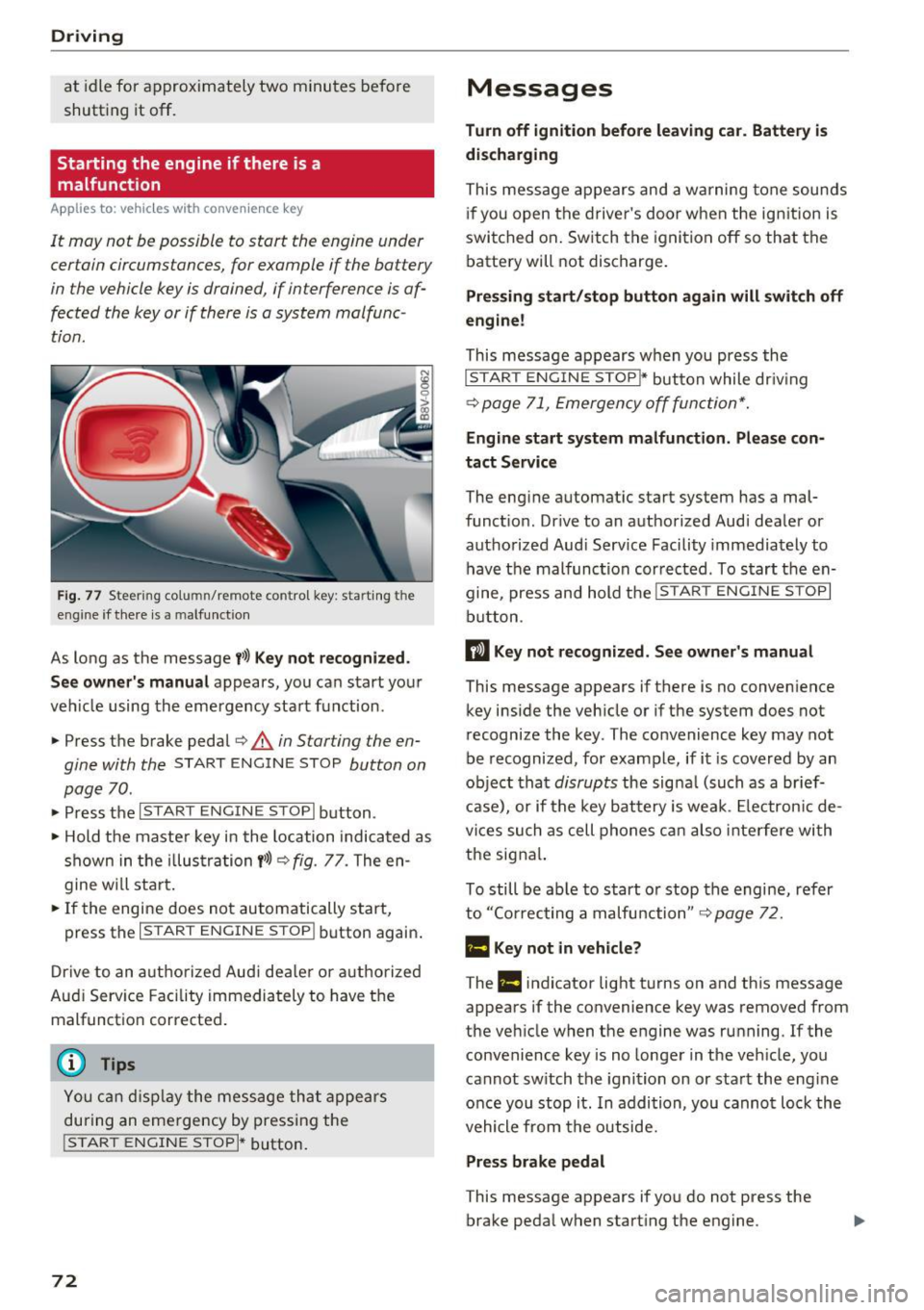
Driving
at idle for approxim ately two minutes before
shutting it
off.
Starting the engine if there is a
malfunction
A pp lies to: ve hicles w ith conve nien ce key
It may not be possible to start the engine under
certain circumstances, for example if the battery
in the vehicle key is drained, if interference is af
fected the key or if there is a system malfunc
tion .
Fig. 77 Steering co lumn/ remote control key: start ing t he
eng ine if th ere is a malfu nct ion
As long as the message t>>) Key not recognized.
See owner' s manual
appears, you can start yo ur
ve hicle using the emergency sta rt function .
• Press t he b rake pedal ¢
A in Starting the en
gine with the
ST ART ENGINE STOP button on
page 70 .
• Press the ~1s= T~A~R~ T~E~N~G~I~ N~E~s= T=o=P~I b utton .
• Hold t he maste r key in the location indica ted as
shown in the i llus trati on
t>>) Q fig. 77. The en
g ine w ill sta rt .
• If the engine does not automatically start,
press the
I START ENGINE STOPI button again .
D rive to an a uth o riz ed Aud i de aler or a uthori zed
Aud i Serv ice Facility immediately to have the
malfunct io n corrected .
Y ou ca n disp lay the me ss a ge th at appe ars
durin g an eme rgency by pressing the
!START ENGINE STOPI* button.
72
Messages
Turn off ignition before leaving car. Battery is
discharging
This mes sage appears and a warning tone sounds
i f you open t he drive r's doo r w hen t he ig nition is
swi tched on . Switch the igni tion
off so that the
batte ry will not discharge .
Pressing start/stop button again will switch off
engine!
This message appears w hen you press the
I STAR T EN GINE STOP~ button while dr iv ing
¢ page 71, Emergency off fun ction*.
Engine start system malfun ction. Please con
tact Service
The eng ine automat ic start system has a mal
funct ion. Dr ive to an a uthorized Audi dea le r or
authorized Aud i Serv ice Facility immedia tely to
have the malfunct ion cor rected. To s tart the en
gine, press an d hold the
I START ENGINE STOPI
button.
II Key not re cogniz ed. S ee owner 's manual
This message appears if there is no conven ience
key i nside the vehicle or if the system does not
recognize the key . The convenience key may not
be recognized, for example, if i t is covered by an
ob ject tha t
disrupts the signa l (such as a br ief
c a se), or if the key battery is we ak. Elec tron ic de
vices such as cell phones c an also inte rfe re wi th
the signa l.
To still be ab le to start o r stop the engine, refer
to ''Co rrecting a malfu nction"
Q page 7 2.
Ill Key not in vehicle?
The Ill indicator light t urns on and th is message
appears if the convenience key was removed from
the vehicle when the engine was ru nning. If the
convenience key is no longe r in the veh icle, yo u
cannot sw itch the ignition on or sta rt the e ng ine
o nce you stop it . In addition, you canno t loc k the
vehicle from the outside.
Press brake pedal
This message appears if yo u do not press the
brake peda l when starting the engine.
Page 74 of 272
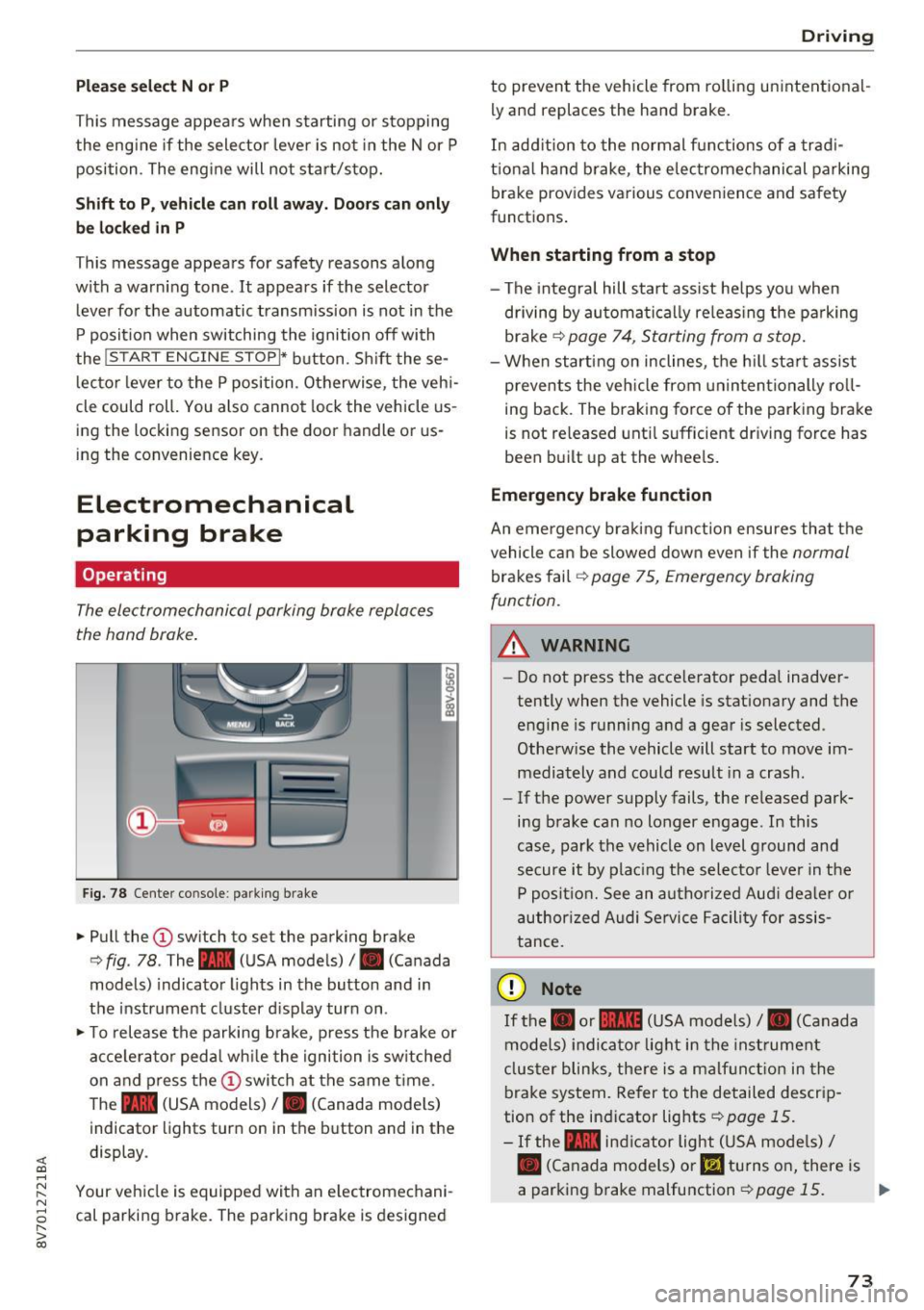
<( co ..... N
" N ..... 0
" > 00
Please select N or P
This message appears when starting or stopping
the eng ine if the selector lever is not in the Nor P
position . The eng ine will not sta rt/stop.
Shift to P , veh icle can roll away. D oors can onl y
b e loc ked in P
This message appears for safety reasons along
with a warning tone.
It appears if the selector
l ever for the automatic transmission is not in the
P posit ion when switching the ignition off with
the
! STAR T ENGINE ST OPI* button . S hi ft these
l ecto r lever to the P position. Otherwise, the veh i
cle could roll. You also cannot lock the vehicle us
ing the locking sensor on the door handle or us
ing the convenience key .
Electromechanical
parking brake
Operating
The electromechanical parking brake replaces
the hand brake .
Fig. 78 Center console : p arking brake
.,. Pull the (I) sw itch to set the park ing brake
c> fig . 78 . The - (USA models)/ . (Canada
models) indicator lights in the button and in
the instrument cluster d isplay turn on .
.,. To release the parking brake , press the b rake o r
acce lera to r ped al wh ile the igni tion is sw itched
on and p ress the
(D swi tch at the same t ime.
The - (USA models) /. (Canada mode ls)
indicator lights turn on in the b utton and in the
display .
Your veh icle is equipped with an e lectromechani
cal parki ng b rake. The park ing brake is designed
D rivi ng
to prevent the vehicle from ro lling unintent ional
ly and replaces the hand brake.
In add ition to the normal f unctions of a trad i
t iona l hand b rake, the elec tromechanical parking
brake provides va rious convenience and safety
functions .
When starting from a stop
- The integral hill start assist he lps yo u when
driving by automa tically re leas ing the pa rking
brake
c> page 74 , Starting from a stop.
- When starting on inclines, the h ill sta rt assist
p revents the veh icle from un in tentionally ro ll
ing back . The braking force of the parking brake
is not re leased unt il sufficient dr iving force has
been b uilt up at the whee ls.
Emergency brake function
An emergency bra kin g f unction ensures that the
vehicle can be slowed down even if the
normal
brakes fail c> page 75, Emergency braking
function .
A WARNING
---=---Do not press the acce le rator pedal inadver
tently when the vehicle is stat ionary and the
engine is running a nd a gear is selected.
Othe rw ise the vehicle will start to move im
mediately and could result in a crash.
- If the power supply fails, the re leased park
ing b rake can no longer engage . In this
case, park the vehicle on level ground and
secure it by plac ing the selecto r leve r in t he
P positio n. See an a utho riz e d Aud i dea le r o r
author ized A udi Se rvice Facility for assis
tance.
(D Note
If the . or 111111 (USA mo dels) /. (Canada
models) indica to r lig ht in the inst rument
clus ter blinks, the re is a malf unc tion in the
brake system. Refer to the detailed descrip
tion of the indicator lights
i=>page 15.
-If the - indic a tor light (USA mode ls)/
• (Canada models) or
l!I turns o n, there is
a parking brake malfunction
c> page 15. ..,_
73
Page 75 of 272
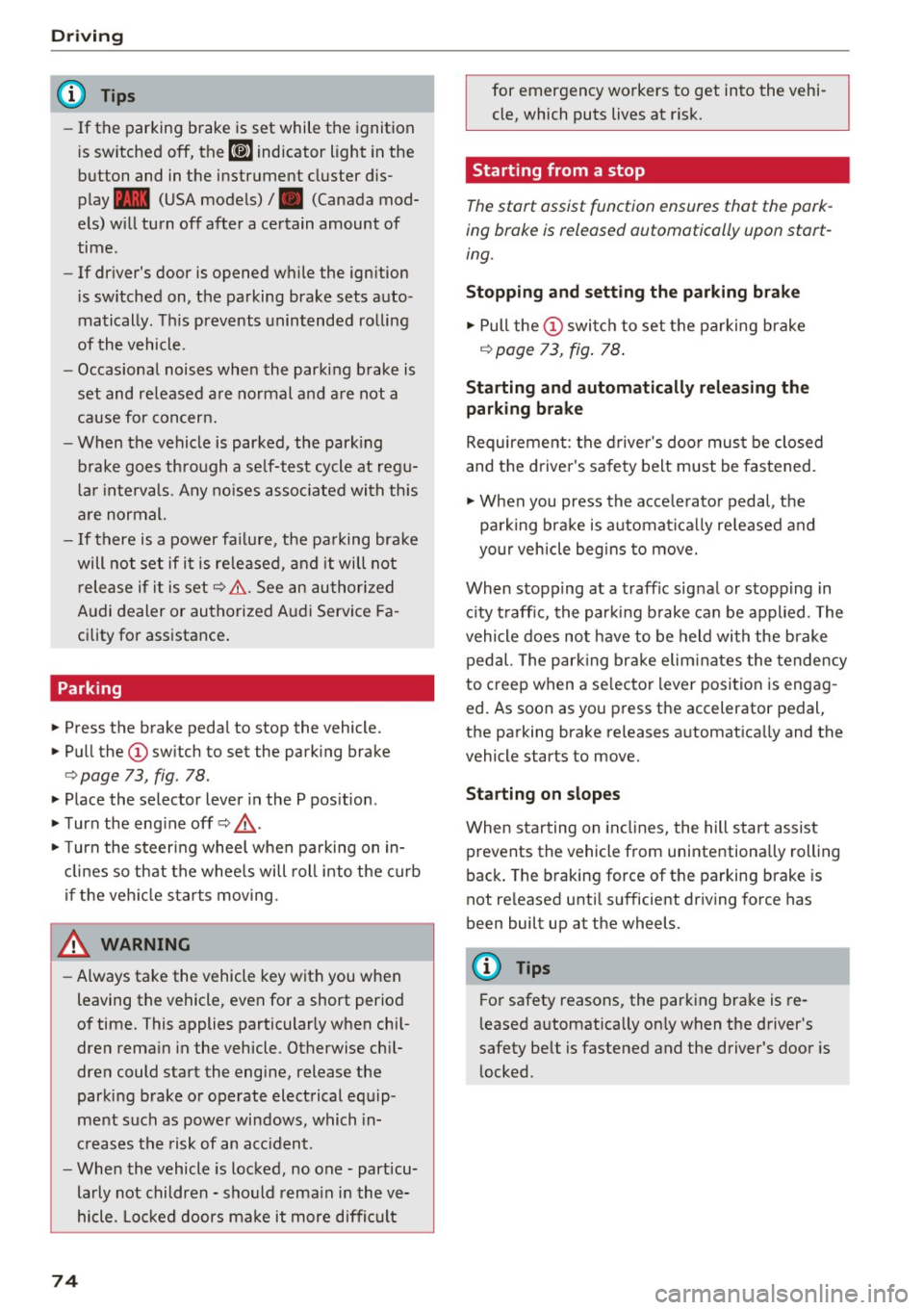
Driving
(D Tips
-If the parking brake is set while the ignition
i s sw itched off, the
tG)a indicator light in the
b utton and in the instrument cluster dis
play - (USA models)/ . (Canada mod
e ls) will turn off after a certain amount of
time.
- If dr iver's door is opened while the ign ition
i s sw itched on, the pa rking brake sets a uto
ma tically. T his prevents unin tended ro lling
of the vehicle.
- Occasiona l noises when the parking brake is
set and re leased a re no rmal a nd a re not a
cause for con cer n.
- When the vehicle is par ked, the park ing
b rake goes thro ugh a se lf-test cycle at reg u
l a r int erva ls. A ny no is es asso ciated with th is
a re normal.
- If t here is a power fa ilure, the p arking bra ke
will not se t if i t is re le a se d, and it will not
r ele ase if it is set¢.&.. See an au thori zed
A udi dealer or au thorized A ud i Service Fa
cility for ass istance .
Parking
~ Press the brake pedal to stop the vehicle.
~ Pull the (D switch to set the park ing brake
¢ page 73, fig. 78 .
~ Place the selector lever in the P pos ition.
~ Turn the eng ine off ¢&_ .
~ Turn the steering whee l when pa rking on in
clin es so that the whee ls will roll into the curb
if the ve hicle starts mov ing .
A WARNING
-Always take the vehicle key with you when
leaving the vehicle, even fo r a short period
of time. This applies particularly when chi l
dren rema in in the veh icle . Otherwise ch il
dren could start the engine, release the
par kin g brake or operate elect rical eq uip
me nt such as powe r windows, which in
c reases the ris k of an acc ident.
- When the vehicle is locked, no one -particu
larly not children -sho uld rem ain i n the ve
hicle. Loc ked doors ma ke it more diffic ult
74
-
for emergency workers to get into the vehi
cle, which puts lives at risk.
Starting from a stop
The start assist function ensures that the park
ing broke is released automatically upon start
ing.
Stopping and sett ing the parking brake
~ Pull the (D swi tc h to set t he pa rking brake
¢ page 73, fig . 78 .
Starting and automatically releasing the
parking brake
Require ment: the d river 's doo r mus t be closed
and the driver 's sa fe ty belt must be fastened.
~ When you press the acce lerato r pedal, the
parking bra ke is a utomat ica lly re leased and
your veh icle begi ns to move.
When stopp ing at a traff ic signa l or stopping in
c ity traff ic, the par king b rake can be applied . The
vehicle does no t have to be held wi th the brake
pedal. The par king bra ke elim inates the ten dency
to creep when a se lector lever posi tion is engag
ed. As soon as you p ress the accelerator pedal,
the parking brake releases a utomat ica lly and the
vehicle starts to move.
Starting on slopes
When star ting on in cli nes, the hill start assist
prevents the vehicle from unintentiona lly rolling
b ack . The b raking force of t he parking brake is
not re leased unti l sufficient dr iv ing force has
been built up at the wheels.
@ Tips
F o r safety reasons, the parking brake is re
l eased a utomatica lly on ly when the driver 's
safety be lt is fastened and the driver's door is
l ocked.
Page 76 of 272
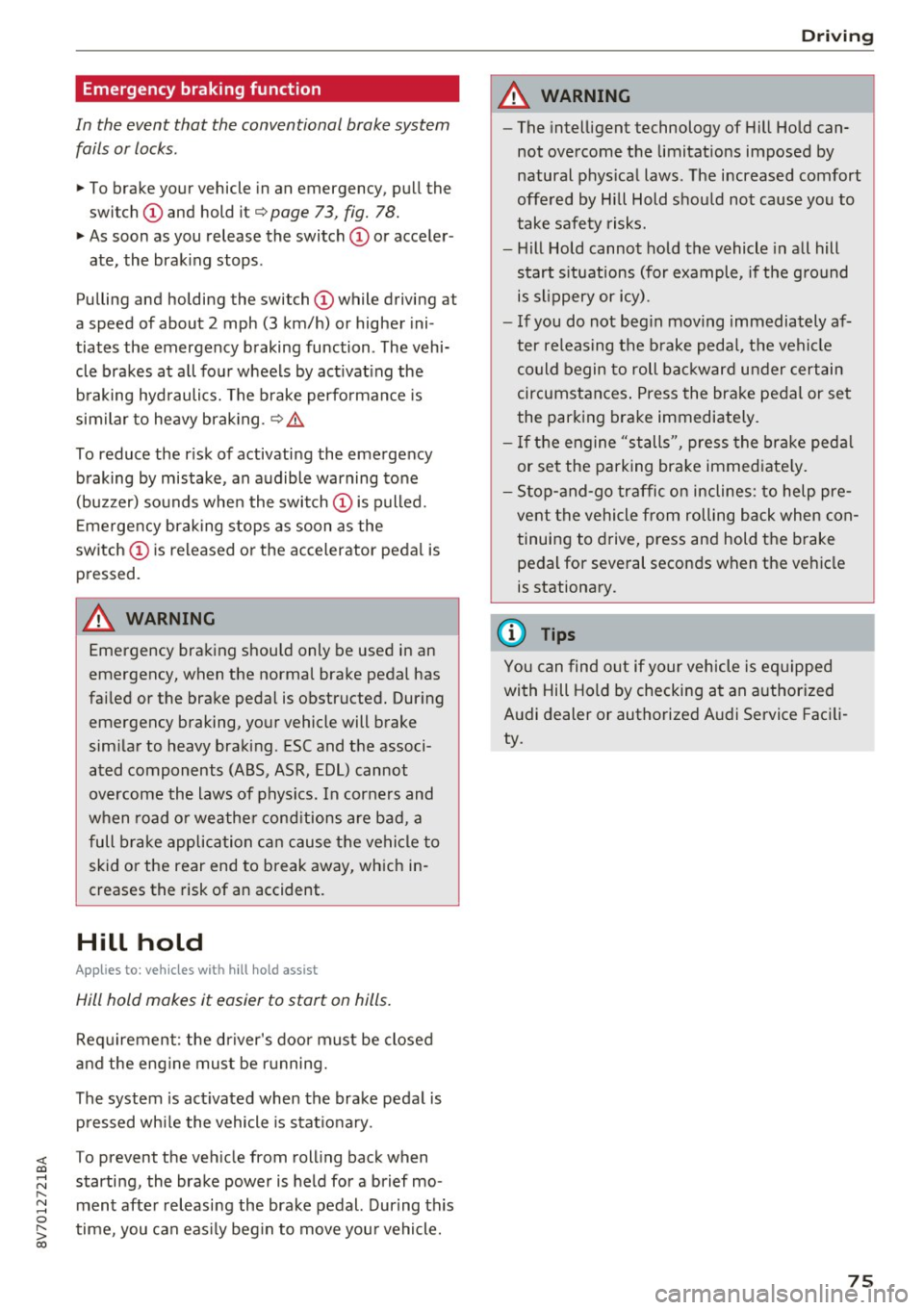
<( co .... N r--N .... 0 r--> co
Emergency braking function
In the event that the conventional brake system
fails or locks.
11-To brake your vehicle in an emergency, pull the
s wi tch (D and hold it¢
page 73, fig. 78.
11-As soon as you release the switch (Dor acceler -
ate , the brak ing stops.
Pulling and holding the switch (D while driving at
a speed of about 2 mph (3 km/h) or higher ini
tiates the emergency b raking function . The vehi
cle brakes at all four whee ls by act ivat ing the
b raking hydrauli cs. The b rake perfo rmance is
sim ilar to heavy braking.¢.&
To reduce the r isk of activating the emergency
braking by mistake, an audible warning tone
(buzzer) so unds when the switch (Dis pulled.
E mergency braking stops as soon as the
switch (Dis released o r the accelerator pedal is
pressed.
A WARNING
Emergency braking should only be used in an
emergency, when the normal brake pedal has
failed or the brake pedal is obstructed. Dur ing
emergency braking, your vehicle will brake
sim ilar to heavy braking . ESC and the associ
ated components (ABS, ASR, EDL) cannot
overcome the laws of physics. In corners and
when road o r weathe r cond itions are bad, a
full brake application can cause the vehicle to skid or the rear end to break away, wh ich in
creases the risk of an accident.
Hill hold
Appl ies to: ve hicles with hill hold assist
Hill hold makes it easier to start on hills.
Requiremen t: the d river's door must be closed
and the eng ine must be r unning.
The system is act ivated when the brake pedal is
p ressed wh ile the vehicle is stat iona ry .
T o prevent the veh icle from rolling back when
starting , the brake power is held for a brief mo
ment afte r releasing the brake pedal. Dur ing this
time, you can eas ily beg in to move you r vehicle.
D riv ing
A WARNING
- The intelligent technology of Hill Hold can
not overcome the limitat ions imposed by
natural phys ical laws. The increased comfort
offe red by Hi ll Hold shou ld no t cause you to
take safety risks.
- Hill Hold cannot hold the vehicle in a ll hill
start s ituations (for example, if the g round
is slippery or icy) .
- I f you do not beg in moving immediately af
ter releasing the b rake peda l, the vehi cle
could begin to roll ba ckward under certain
circumstances . Press the bra ke pedal or set
the parking brake immediately .
- If the engine "stalls", press the brake peda l
or set the parking bra ke immed iate ly.
- Stop-and-go traffic on inclines: to help pre
vent the vehicle from rolling back when con
tinuing to drive, press and hold the brake
pedal for several seconds when the vehicle
is stationary.
(D Tips
You can find out if your vehicle is eq uipped
with Hill Hold by checking at an authorized
A udi dealer or authorized Audi Service Fac ili
ty.
75
Page 78 of 272

<( co ..... N
" N ..... 0 r--. > 00
-Never select R or P while driving, because
this increases the risk of an accident.
- Power is sti ll transmitted to the wheels
when the engine is running at idle. To pre
vent the vehicle from "creeping" , you must
keep your foot on the brake in all selector
lever positions (except P) when the engine is
runn ing . Otherwise, th is increases the r isk
of an accident.
- Do not inadvertently press the accelerator
peda l when the veh icle is stopped if a gear is
engaged . Otherwise the veh icle w ill start to
move immediately, even if the pa rking brake
is set . Th is cou ld res ult in a crash.
- Do not press the accelerator pedal when
changing the selector lever pos ition while
the vehicle is stationary and the engine is running .
- Never leave yo ur vehicle wi th t he engine
running wh ile in gear. If yo u must leave
your vehicle when the engine is running, set the parking brake and move the selector lev
er to the P position.
- Due to an accident risk, the selector lever
must be in the
P pos ition and the parking
brake must be set before opening the hood
and working on a running engine. Always
read and follow the applicable warnings
¢ page 188, Working in the engine com
partment .
(D Note
Never let the veh icle roll downhill with engi ne
off and the selector lever in the N position,
because this could damage the automatic
tra nsmission and cata lytic converter .
@ Tips
- Audi drive select: Sporty shifting character
i stics can be selected using the
D ynamic
d riving mode. 5 wi ll appea r in the in stru
ment cluster disp lay instead of D .
- If yo u accidentally select N while driv ing ,
take your foot off the accele rato r pedal im
med iate ly and w ait for the engine to slow
down to idle before se lecting Dor 5 .
Automa tic tr ansm iss ion
-If there is a power failure, the se lector lever
wi ll not move out of the P position. The
eme rgency re lease can be used if t his hap
pens
¢ page 83 .
Selector lever lock
Applies to : vehicles with automatic transmissions
The s elector l ever lock prevents you from sel ect
ing a gear occidentally , causing the veh icle to
roll .
Fig . 80 Sele cto r lever lock
To release the se lector lever lock:
.,. Switch on the ign ition .
•
lll 0 0
> a,
lock button .
Automatic shift lock (ASL)
The selector lever is locked in the P a nd N posi
t ions when the ignition is switched on. You must
press the brake pedal to select another position .
You must also press the interlock button if you
are moving from the P position. The following
message appears in the d isplay when the se lector
lever is in the P or N posit io n to rem ind the driv
er:
When station ary apply footbrake while select
ing
gear
T he automatic sh ift lock only funct ions w hen the
vehicle is stat ionary or at speeds below I mph
(2 km/h) . At higher speeds, the lock is au toma ti
ca lly deac tiva ted in the N pos it ion.
T he selector lever is not locked when shifting
quickly through N, for example from R to D . This
makes it possibl e to free the vehicle when it is ..,.
77